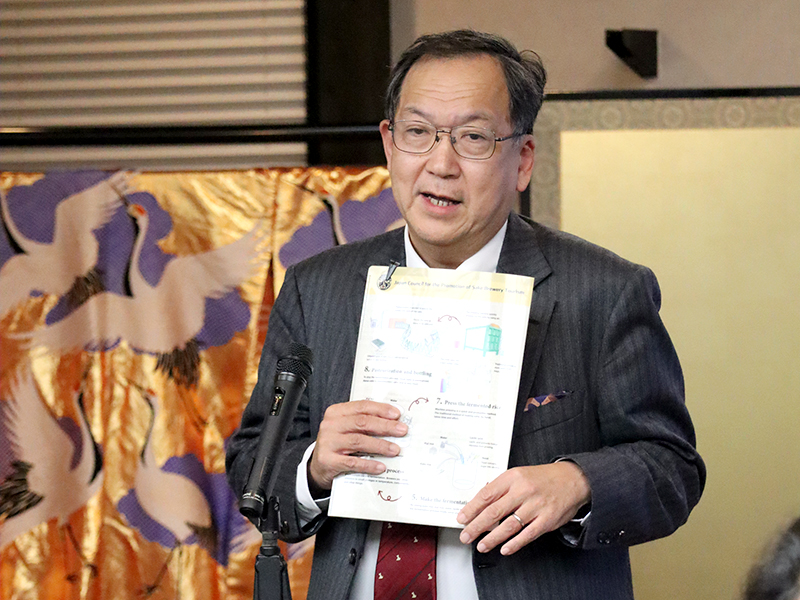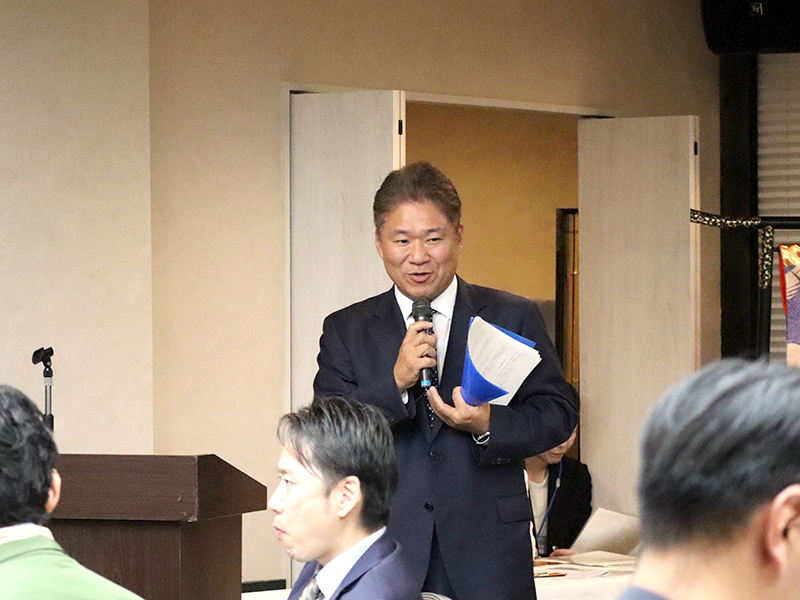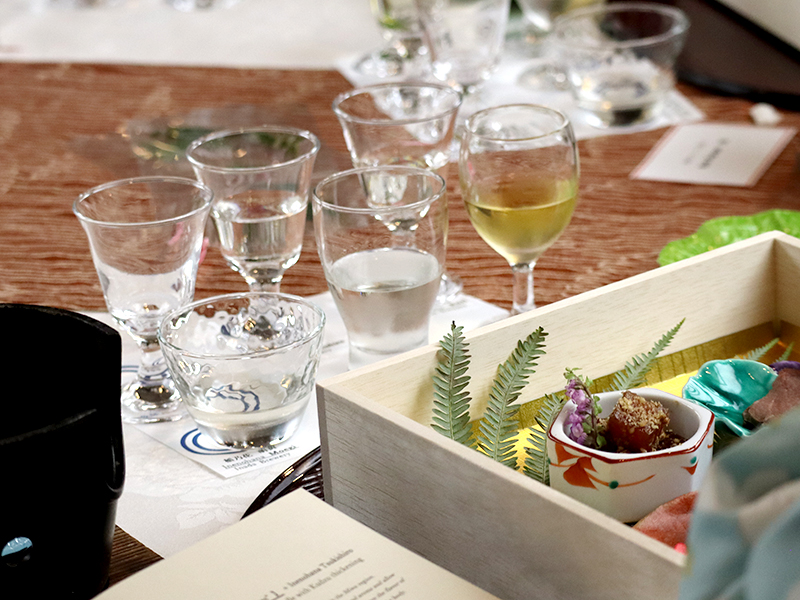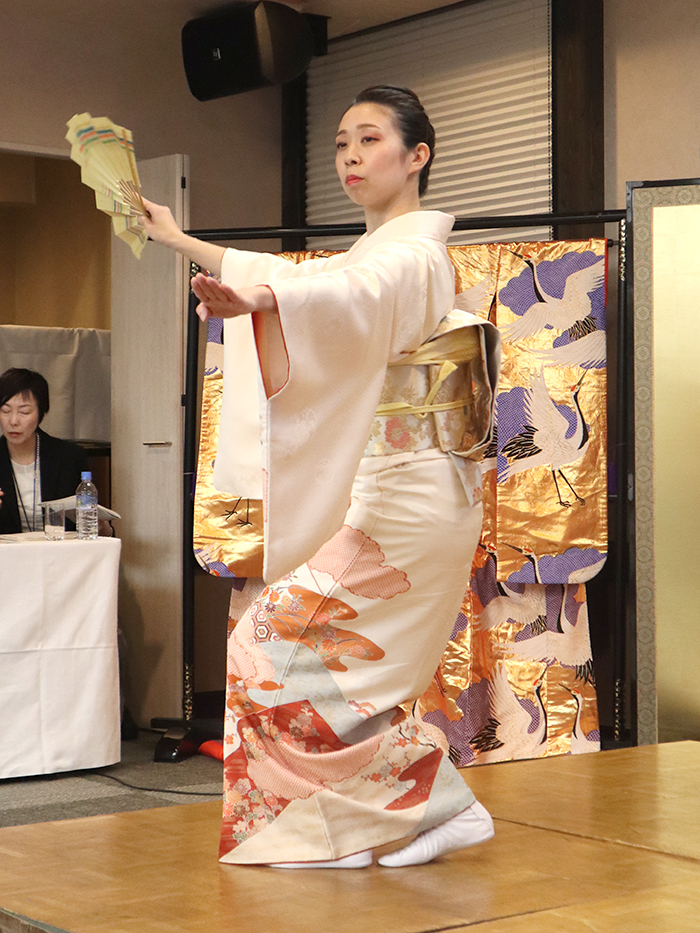Enjoy Nara’s delicious sake wearing a kimono!
“Japanese cuisine is Japan’s proud food culture. Its roots are in Nara.” The “Japanese Food Pilgrimage – NARA” project plans gastronomy tourism where you can learn about the roots of Japanese food and experience the culture. Six diverse programs have started in 2023 as well.
The third such event was held on November 20 at Hotel Agile Nara’s Yamatoji, welcoming 31 guests.This year’s event was held under the theme of “Kimono,” Japanese kimonos that are popular around the world, and was a gorgeous marriage of food and Nara sake. The highlight of the event was a Japanese dance performance.
As with the first and second events held at Nara Hotel on October 22 and Hotel Nikko Nara on November 5, materials and menus will be available in Japanese and English.Two interpreter-guides simultaneously translated the moderator’s and guest’s speeches to take care of the foreign participants.
*This event was held as the 3rd demonstration project of the Japan Tourism Agency’s regional integrated gastronomy tourism promotion project. From Nara, the birthplace of Japanese sake and home to various Japanese food culture roots, we will disseminate the new NARA brand both domestically and internationally, and create new products and develop sales channels targeting the ever-increasing number of foreign visitors to Japan. The purpose is that.

Kimono dressing experience for those who wish to try it on
Smiles burst forth at the more-than-imaginable results!
Thirteen people requested the optional kimono dressing experience.Six international students from six countries, including Belgium, Malaysia, and Colombia, four people from European and U.S. consulates in Osaka, and three Japanese women, including a travel agent, each selected a kimono and obi from a list provided by a kimono stylist (Kyo-Roman Group Holding Co., Ltd.) and tried on the kimono by themselves.



They put on tabi (split-toed socks), underwear, kimono, and obi, and the foreign student boys put on haori (a Japanese traditional coat). The foreign student boys also put on their haori, touching their haori cords excitedly and a little proudly, and complimenting each other on how well they looked on each other.The female students showed their full smiles as they marveled at the glamorous figure that exceeded their expectations, saying “wow!
While waiting for the dinner to begin, the guests were excited to be dressed in kimonos, and their voices were lively as they introduced themselves, making for a lively conversation.

Nara Sake Gastronomy Dinner at a gorgeous Japanese-style venue decorated with gorgeous Uchikake
The venue was filled with a display of colored wedding kimonos by “Ryorankinshu”, and guests were welcomed with Japanese flair.People from more than seven countries wearing kimono were seated at each table, and it seemed to be a good opportunity to start conversations among those who were meeting for the first time.
Prior to the opening of the banquet, the organizer, Tokuko Kawai, chairperson of the project executive committee, gave an opening speech.He talked about the purpose, objectives, and vision of the project, and called for the importance of inheriting Japanese culture, including clothing, food, and traditional performing arts, and the importance of communicating this to the world as our mission, which could lead to the true SDGs. He then invited the audience to “enjoy Nara’s delicious sake and gastronomic delights!
Greetings from Guest of Honor – Greetings from Guests of Honor
World Peace through "Japanese brewed sake
Next, Mr. Masahiro Sugino, Executive Director of Sake Brewery Tourism, Japan Tourism Promotion Association, which specializes in tourism to Japanese sake and sake brewery culture, gave the guest of honor’s address.Mr. Sugino quoted the phrase “Wa zenryo yoshu” (“Japanese spirit brews good sake, and good sake brews Japanese spirit”), saying that the spirit of harmony can lead the world to peace.


Mr. Kiyoharu Udo, Director of Kasuga Taisha’s Planning Department, led the toast with the words “Iyasaka! (meaning “I want to finally prosper and be loved”), and all the participants chanted the words in unison.The toast was “Inanohana White (Tsukumo)” (Inada Shuzo), a light, tropical sweet and sour sake brewed with 99% koji ratio.
Respecting the UNESCO Intangible Cultural Heritage "Japanese Food" culture, cuisine with the theme of Nara, the roots of Japanese Sake & UMAMI
Following the “Tsukumo” toast, six varieties of “Inanohana Series,” a series of innovative sake made by Inada Shuzo, were served one after another.

The explanation included “I-no-Bon” for a special Hare experience, “II-Bon” with basic Japanese soup stock and Nara’s medicinal herbs, “III-Bon” with Nara’s local cuisine, and “Dessert.” We hope you enjoy the different tastes of miso, a fermented food, depending on whether you cook it by boiling or baking, and we also hope you enjoy grilled rice balls with our special “soup stock” as chazuke (rice with green tea) and “umami” (deliciousness) with all your five senses.



Brewer talk from Mitsumori Inada, 5th generation Inada Shuzo brewer
Traditional and innovative sake brewing in Nara, the birthplace of Japanese sake
Six types of sake were prepared in front of each guest to pair with the chef’s full-fledged dishes, all of which are from the Inenohana series, an innovative sake brewery created by Mitsumori Inada, the fifth generation of Inada Sake Brewery. was. Mr. Inada spoke about the history and characteristics of sake brewing in Nara, the birthplace of Japanese sake.
He also talked about the “sumizake,” “baiju,” and “kuroki” found in a wooden letter excavated from the Heijo Palace site dating back 1,300 years, “umazake” found in the Manyoshu, and that the brewing technology for Japanese sake was established at a medieval temple, and that the yeast “bodaimoto” was restored at Shorekiji Temple in Nara City.


He also emphasized that “Nara pickles,” made from sake lees, a byproduct of sake brewing, are also a specialty of Nara in the spirit of the SDGs.He also mentioned his company’s innovative sake brewed through friendly competition in the historically high-level Nara sake-producing region, and shared an episode in which he was excited to take on the challenge of this year’s heat wave.
The sake corner features 11 kinds of rare sake, both cold and hot.Two types of freshly pressed sake from "Harushika"
Now, the banquet began with high expectations for the dishes to be brought to the table.At the Nara Sake Corner set up in one corner of the venue, 11 different kinds of sake were prepared both cold and hot, with Mr. Kazuyuki Mizugami of the Nara Sake Brewers Association standing by. Mr.Mizukami of the Nara Sake Brewers Association was standing by to answer questions from the guests while selecting and pouring the recommended sake into their glasses.
At the center of the lineup were two well-known “Harushika” sake brands, the first-batch nama sake brewed with this year’s new rice and the junmai ginjo “Harushika Junmai Super Dry,” which was introduced by Kiyotaka Imanishi, president of Seibei Imanishi Shoten Co. as “a refreshing, fragrant, and gorgeous sake.


Kimono talk by Chihiro Igari of Kyo-Roman and Japanese dance by Sensho Yasuchisaya of the Sensho style
In the middle of the party, as the tables were getting excited at the Nara sake corner, Chihiro Igari of Kyo-Roman talked about kimonos.
The kimono has a long history, but nowadays it is only worn on special occasions. However, interest in kimono fashion is growing among people overseas. I would like to further promote kimono culture.
This was followed by a dazzling performance of Japanese traditional dance by Sensho Yasuchisaya of the Sensho style. The first piece was “Kotobuki the Crane” and the second was “Wisteria Fantasy” on the stage in front of the golden folding screen.


After the dance, Ms. Sensho told the audience that there are two types of Japanese dance: 1) those that have a story like a musical (mime dance), and 2) those that capture the four seasons of Japan and use the lyrics to describe the situation.
A guest in kimono said, “It was difficult to understand, but I could feel traditional Japanese culture. I would like to learn more about it.
"Thank you for this opportunity♪" "A project I'd like to tell people about ♪ "
Drums of "bravo project" from people in kimono!
At the end of the dinner, we asked five people dressed in kimono what they thought of the dinner. A woman from the travel industry said, “This is the first time for me to experience the pairing of alcohol and food. I would like to tell the tour planners about this experience,” said one participant. “I really enjoyed the marriage of traditional Japanese culture, Nara sake and Japanese food,” said another.


The MC concluded the event by saying, “Nara, the birthplace of Japanese sake, is home not only to sake, but also to the roots of traditional Japanese culture. Let’s share Nara’s various attractions and new forms of tourism with the rest of the world from “Nara, the place where it all began,”” he concluded.
